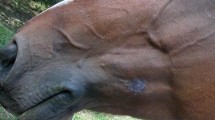Abstract
Dermatophytic infections of the skin, hairs and nails are very common and are very variable in aspect. In skin, inflammatory symptoms are often absent, but in other cases they may be very pronounced, in particular when caused by zoophilic dermatophytes. In onychomycosis, it is very difficult to make the differential diagnosis with other causes of onychodystrophy on purely clinical grounds; indeed, even in case of fungal infection, the causative agent can be suspected on clinical grounds only in a minority of cases. The clinical presentation of skin infections, infections of the scalp and beard, and the nails are presented more in detail.










Similar content being viewed by others
References
Dahl LA. Dermotophytosis and the immune response. J Am Acad Dermatol. 1994;31[3Pt2]:S34–41.
Wagner DK, Sohnle PG. Cutaneous defenses against dermatophytes and yeasts. Clin Microbiol Rev. 1995;8:317–35.
Jones HE. Immune response and host resistance of humans to dermatophyte infection. J Am Acad Dermatol. 1998;28[5Pt 1]:S12–8.
Bolognia JL, Jorizzo JL, Rapini RP, et al. Dermatology. New York: Mosby;2003. p. 1176–8.
Degreef H, De Doncker P, editors. Fighting fungal infections around the globe. Itraconazole in perspective. Kent: Wells medical holdings;2000. p. 67–70.
Degreef H, De Doncker P, editors. Fighting fungal infections around the globe. Itraconazole in perspective. Kent: Wells medical holdings; 2000. 71 pp.
Bonifaz A, Archer-Dubon C, Saúl A. Tinea imbricata or Tokelau. Int J Dermatol. 2004;43:506–10.
Adams BB. Tinea corporis gladiatorum. J Am Acad Dermatol. 2002;47:286–90.
Romano C, Maritati E, Gianni C. Tinea incognito in Italy: a 15-year survey. Mycoses 2004; 49:383–7.
Bolognia JL, Jorizzo JL, Rapini RP, et al. Dermatology. New York:Mosby;2003. p. 1178–9.
Degreef H, De Doncker P, editors. Fighting fungal infections around the globe. Itraconazole in perspective. Kent: Wells medical holdings; 2000. 67 pp.
Degreef H, De Doncker P, editors. Fighting fungal infections around the globe. Itraconazole in perspective. Kent: Wells medical holdings; 2000. p. 57–61.
Leyden JJ. Progression of interdigital infections from simplex to complex. J Am Acad Dermatol. 1993;28[5 Pt 1]:S7–11.
Rook A, Dawber R. Ringworm of the scalp. In: Infections and infestations: diseases of the hair and scalp. London: Blackwell Scientific Pub;1982. p. 367–85.
Degreef H, De Doncker P, editors. Fighting fungal infections around the globe. Itraconazole in perspective. Kent: Wells medical holdings; 2000. p. 85–9.
Elewski BE. Tinea capitis: a current perspective. J Am Acad Dermatol. 2000;42[1 Pt 1]:1–20.
Mandell GL, Bennett JE, Dolin R. Tinea capitis in dermatophytosis and other superficial mycosis. In: Principles and practice of infectious disease. New York: Churchill Livingstone; 1995:2379–2382.
Andre J, Achten G. Onychomycosis. Int J Dermatol. 1987;26:481–90.
Baran R, Hay RJ, Tosti A, Haneke E. A new classification of onychomycosis. Br J Dermatol. 1998;139:567–71.
Faergemann J, Baran R. Epidemiology, clinical presentation and diagnosis of onychomycosis. Br J Dermatol. 2003;149(Suppl 65):1–4.
Tosti A, Baran R, Piraccini MB, Fanti PA. “Endonyx” onychomycosis : a new modality of nail invasion by dermatophytes. Acta Derm Venereol. 1999;79:52–3.
Author information
Authors and Affiliations
Corresponding author
Rights and permissions
About this article
Cite this article
Degreef, H. Clinical Forms of Dermatophytosis (Ringworm Infection). Mycopathologia 166, 257–265 (2008). https://doi.org/10.1007/s11046-008-9101-8
Received:
Revised:
Accepted:
Published:
Issue Date:
DOI: https://doi.org/10.1007/s11046-008-9101-8




